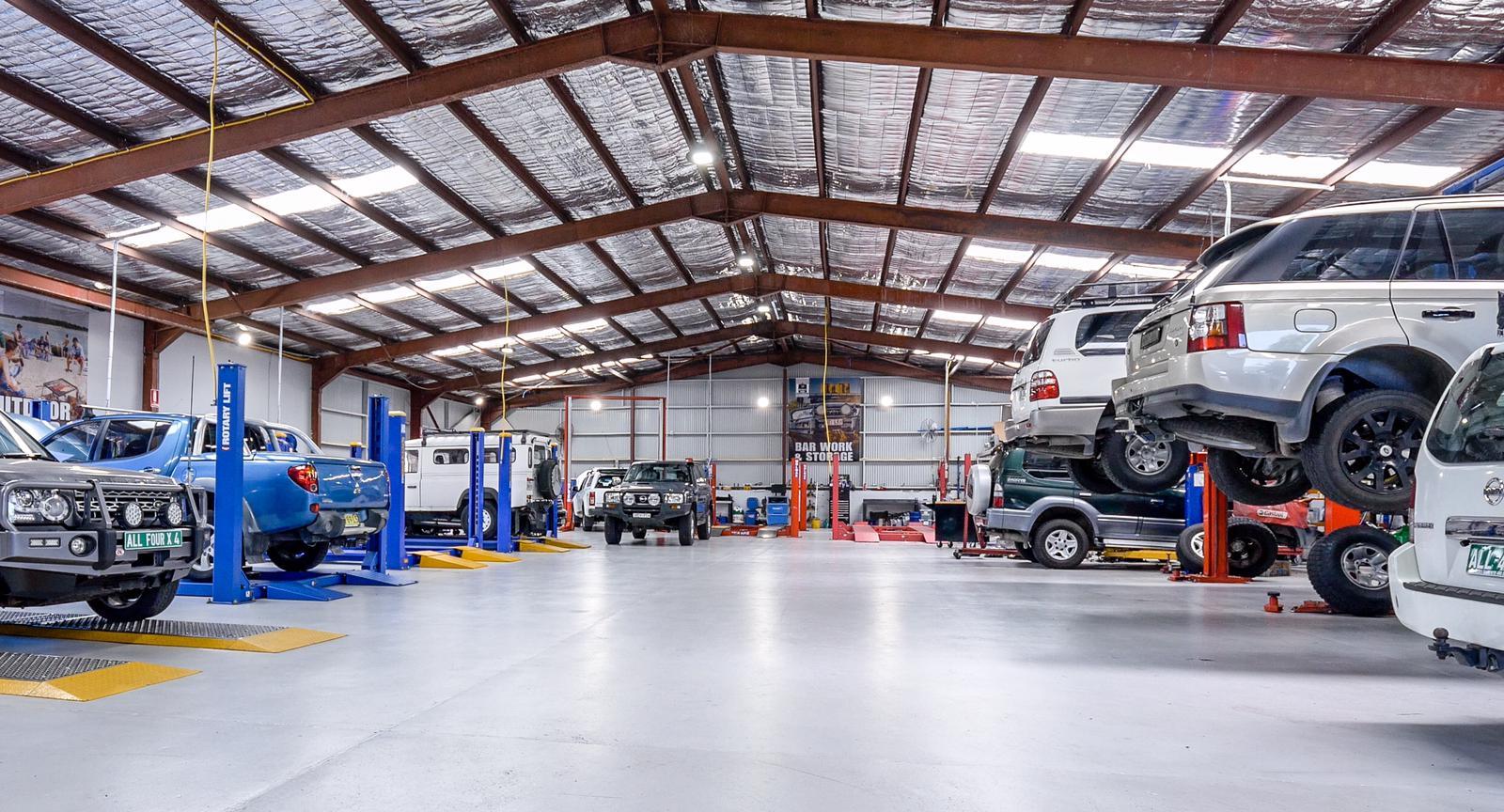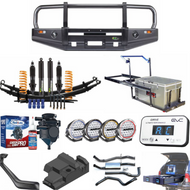Which 4x4 Accessories and Modifications Do You Really Need?
Published by John on 23rd Jul 2020
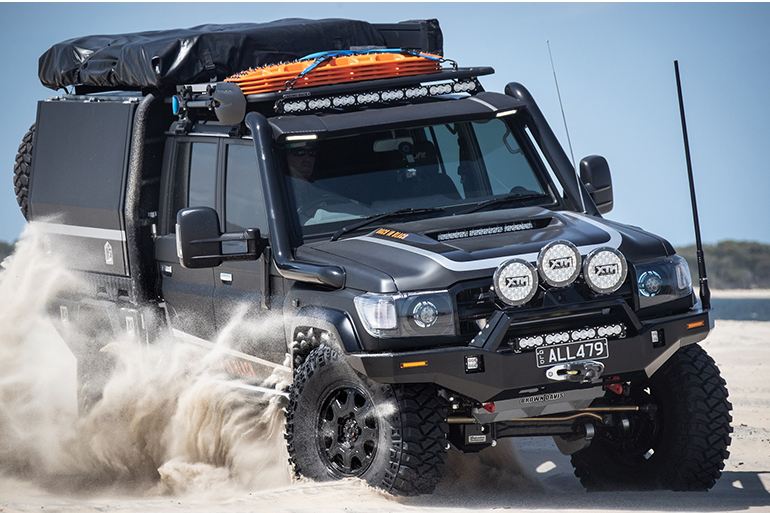
Today we are going to talk about which 4x4 accessories or 4wd modifications you should consider essential "must-have" or "would be nice to have"
After all, with so many products in the market, it can be tricky to differentiate essential to not-so essential accessories.
Let's start from the basics:
- An accessory is usually something not permanently attached to the vehicle, like a fridge, or not directly related to vehicle fitments, such as an electric winch.
- A modification is usually the process of replacing an existing part of the vehicle, like tyres or suspension.
We used the expression "usually" because there could be countless interpretations based on who you ask.
Still, it's fair saying that certain products are must-haves if, for example, you are planning an offroad trip with your family.
Let's split them into the two sections mentioned earlier:
THE ESSENTIAL MUST-HAVE 4WD ACCESSORIES / MODIFICATIONS
Recovery Gear
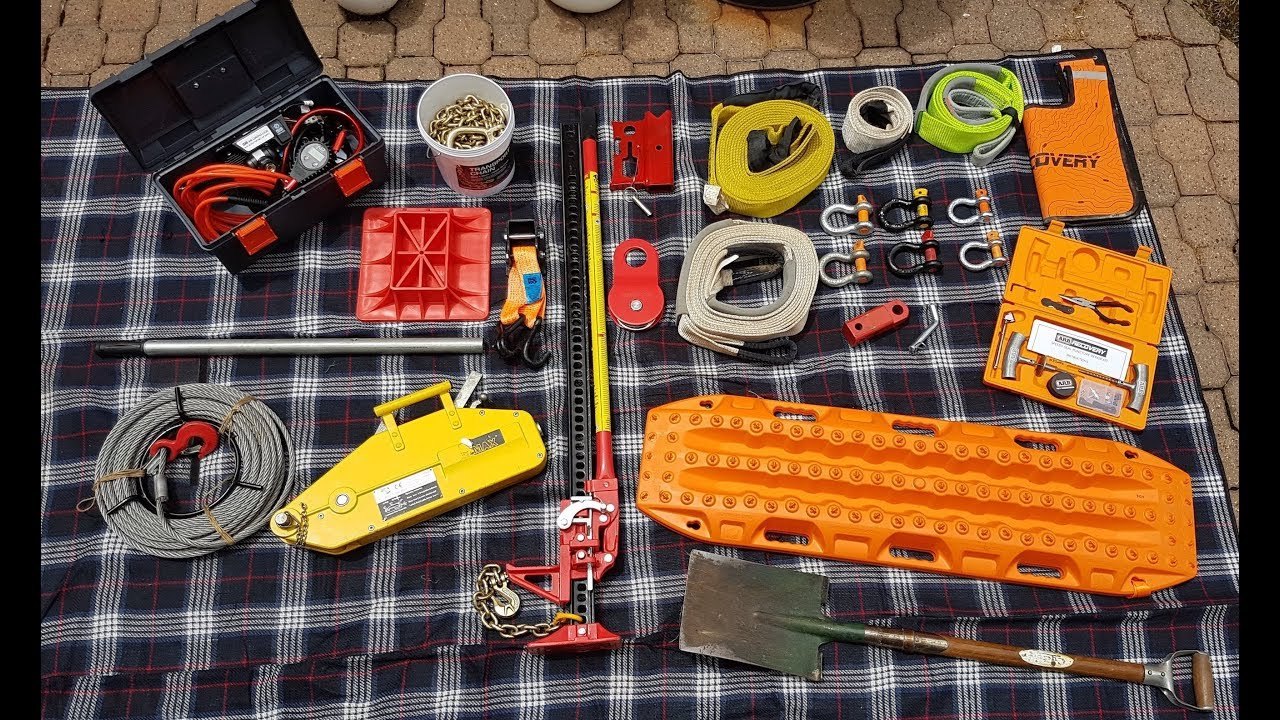
A common approach from novice 4wdrivers is to look at aesthetics first and purchase a sexy looking lift kit thinking it as a must-have to go offroad.
Admittingly they can be much more desirable than let's say a cargo-barrier, a fire extinguisher, radios, or first aid kits.
However let's make this clear: purchase the safety equipment first. You won't regret it for when you may need it.
There are several types of 4wd recovery gear products designed for different recovery situations, and the following lists some of the most popular.
You don't need to have them all but make sure you carry some suitable for the offroad environment you are travelling to.
These include:
Recovery Points:
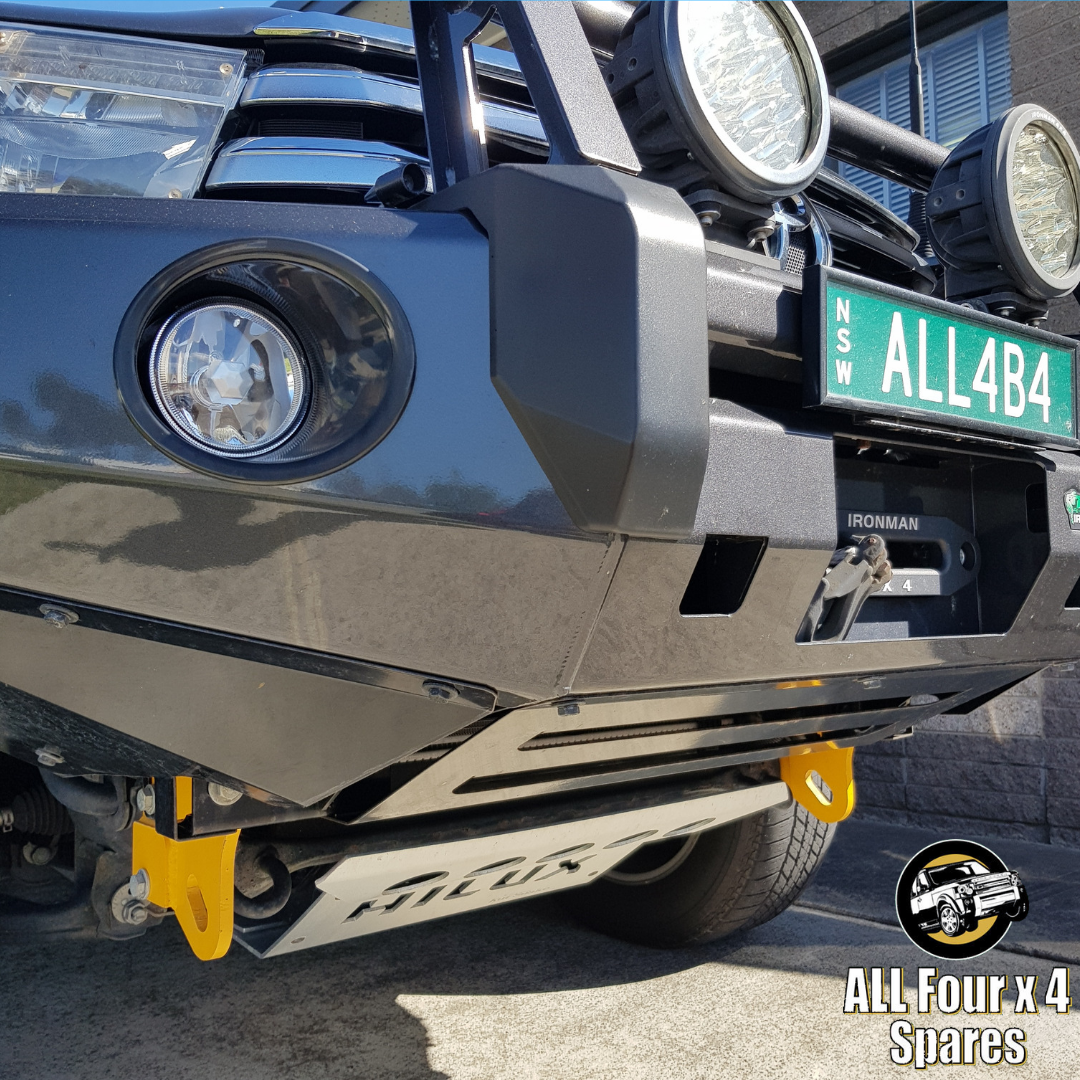
If you get bogged, one way to rescue your vehicle is being pulled with tremendous force.
You need a mounting point for that force.
Don't think that any hook you find in your car will do the job.
Some of those hooks are just tie-downs, designed to stop the vehicle moving when being transported.
The forces involved in vehicle recoveries are much stronger and can rip these tie-down hooks off the vehicle (and that can be very dangerous).
In the front of your car, a couple of recovery points will be convenient.
In the rear, you potentially could use a towbar as a recovery point, provided that they are secured to the chassis of the vehicle.
Sure you may bend the tow hitch, but tests show it takes approx. 10 Tonnes of effort, by which time, you'll probably have broken the snatch strap wrapped to it.
By the way, do not ever use the tow-ball as a recovery point.
Snatch Straps
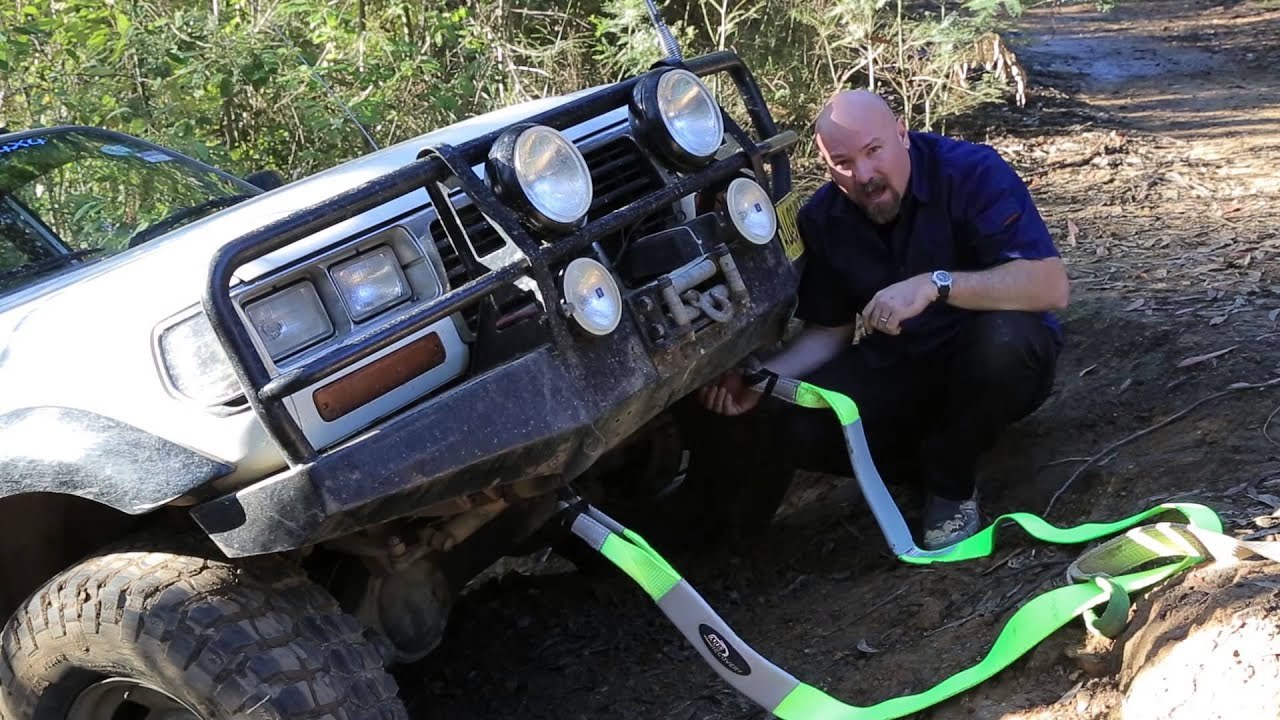
One of the cheapest and most useful items of recovery gear. Although not the safest if misused.
A snatch strap is a giant elastic band made in nylon that can stretch 20 to 30% that attaches to the stuck vehicle on one end and the other end to the recovery vehicle which uses momentum to pull the stuck vehicle free.
Be wary of the ratings. The rating of a snatch strap is the load at which it's designed to break, and they can vary between 6000Kg and 12000Kg.
Car Jacks

You should already carry your vehicle standard jack at all times, so that's one less piece of recovery gear to worry about.
However, depending on where you get stuck, that won't be much of a help.
That is why there are several other types of jacks, each suited to different terrains.
Air jacks (or Exhaust Jacks)

An air jack or also called exhaust jack is a big balloon perfect for sand and soft ground recoveries. You put the deflated air jack underneath your stuck vehicle, connect its input hose to the exhaust and this inflates the bag and lift the car.
Hi-Lift Jacks

They can lift to three Tons vehicles about a meter, and they can also be used for winching and bead breaking.
Hi-lift jacks are great for when you need to lift the car a long way, like when you need to stack rocks under a wheel or cannot get under the body to lift.
The biggest cons of hi-lift jacks are finding a place on the car actually to mount it.
They can only work on the body of the vehicle not under the chassis like the regular car jack.
So not every vehicle have places where a hi-lift jack can be used.
In some instances, a bull bar can be used, but not always, or strong rock slider sidesteps, or metal rear bumpers.
Car Jack VS Air Jack VS Hi-Lift Jack
Here is a comparison table across these three types of recovery jacks
| Car Jack | Air Jack | Hi-Lift Jack | |
| Approximate Cost | Included with car | $250 | $100 |
| Soft ground | With a flat plate | Excellent | With a flat plate |
| Rocky ground | Yes | with care | Yes |
| Suitable for modern vehicles | Yes | Yes | Rarely, few jacking points |
| Height | Approx. 30 cm | Up to Approx 50cm | One metre |
| Other uses | None | None | Winch, bread breaking, panel bending and more uses |
TRACTION DEVICES
The purpose of traction devices is to improve grip, increase clearance, reduce axle flex to put more weight on the wheels and create a ramp.
Since you place them under the wheels, you could potentially use rocks, wood sticks or car mats in case of need, however, there are several great specifically made products designed to recover your car.
Let's go thought some of them:
Flexible traction mats
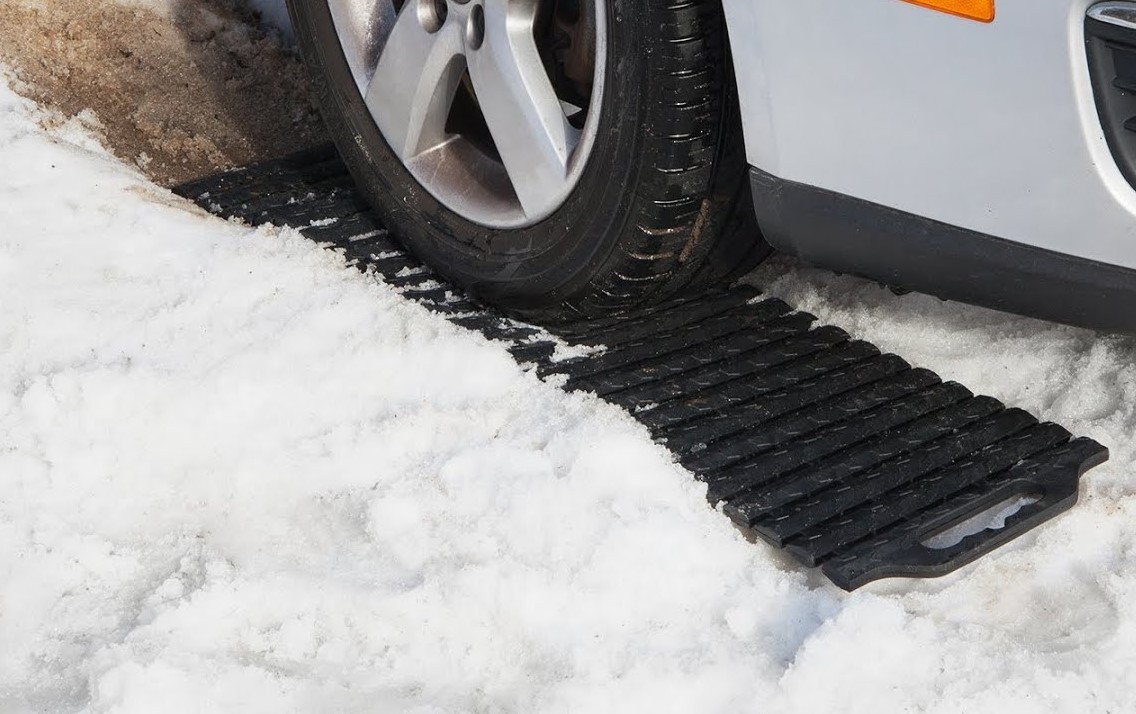
They are light devices with linked tracks and work best in soft surfaces. Easy to transport as they are roll-up nice and tight.
Bridging ramps
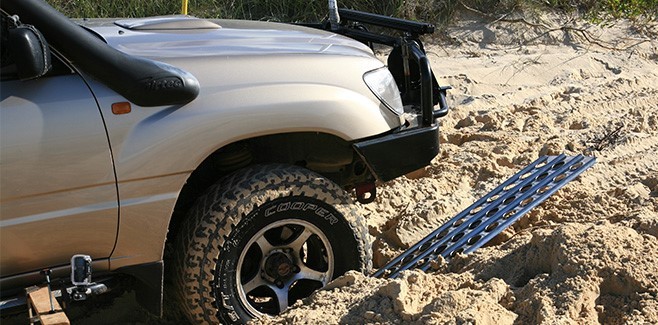
These are heavy and bulky to carry around, but they can be used on any surfaces. They can take the weight of a vehicle's wheel across a gap or can also be jammed under the wheels to create a ramp.
Traction ramps
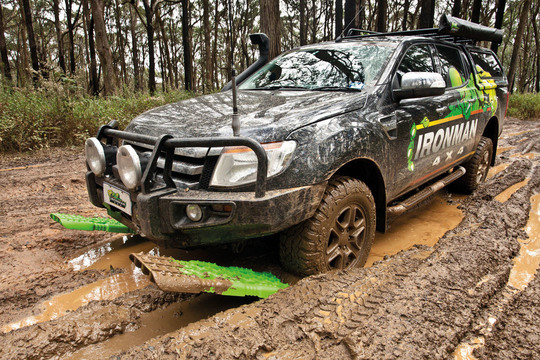
Similar to bridging ramps but they are much lighter and can only be used on soft surfaces. They are quite a popular recovery and extraction devices and can come in different colours.
Inflatable traction aids
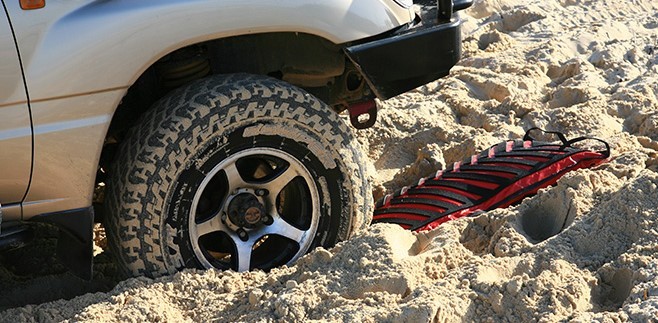
These are like traction ramps but inflatable. They are light and small and can only fill in gaps.
They don't provide the sort of flotation a traction ramp can achieve, but they are better than a flexible traction mat.
The great thing is that they can be used on any surfaces.
Axes

These are not essential recovery devices, but if you drive through thick bush and come across fallen trees blocking your way, you would be glad to have brought one of these with you. A saw and chainsaw will work best, though.
Spades and shovels
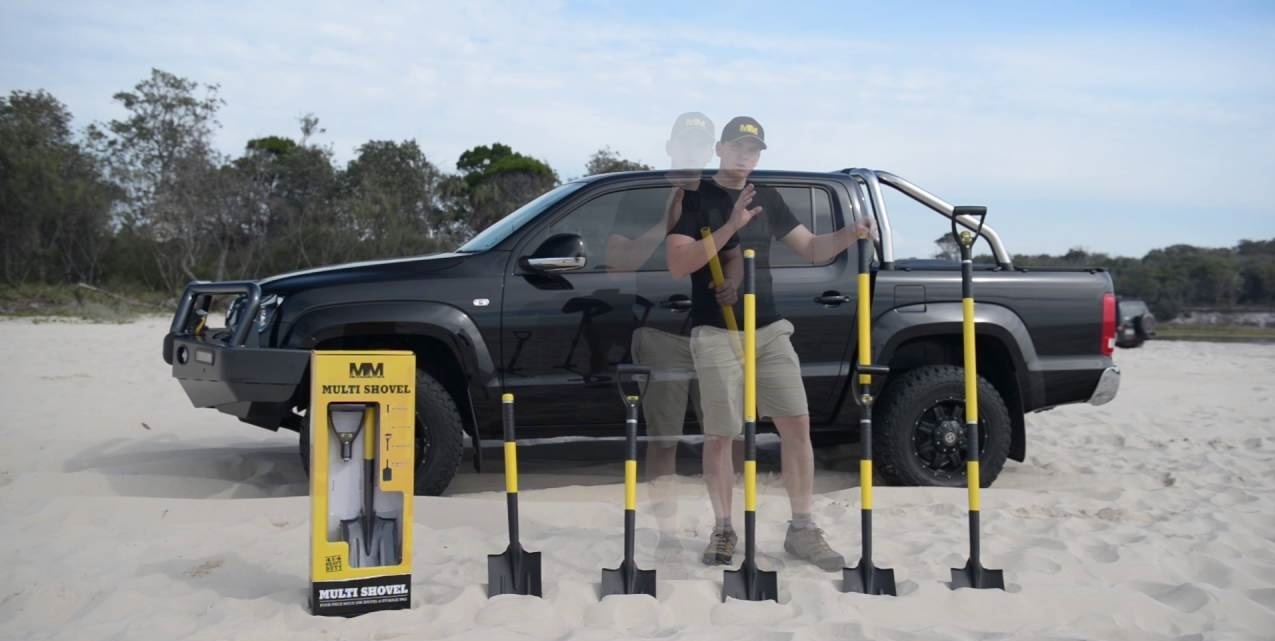
The universal pieces of recovery.
The spade is not as efficient as the shovel for moving loose dirt, but it's far superior for digging.
Shovels are super convenient in the sand. Ideally carry both or get a multifunction tool with different heads for picks, shovels, spade and axes.
Fire extinguishers and fire blankets
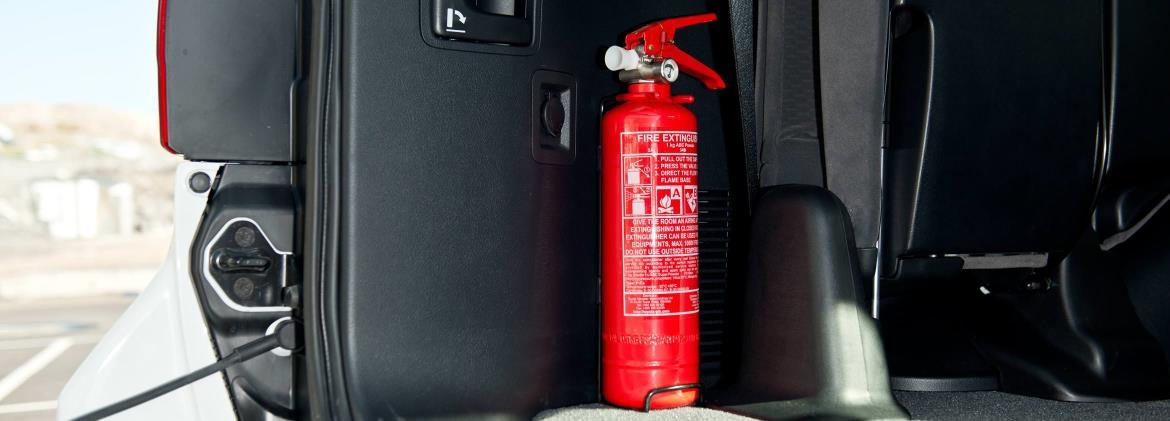
We hope you never come across a vehicle on fire, it's not a pretty sight, but in the event you do, a fire extinguisher will save lives, vehicles and potential bush fires.
If you drive through a powder extinguisher will be the best choice for dry grass catching fire.
For vehicle fires, you will need an electrical extinguisher.
If your cooking oil on the BBQ catches fire, then a fire blanket will do the job.
First Aid kits and Survival Kits
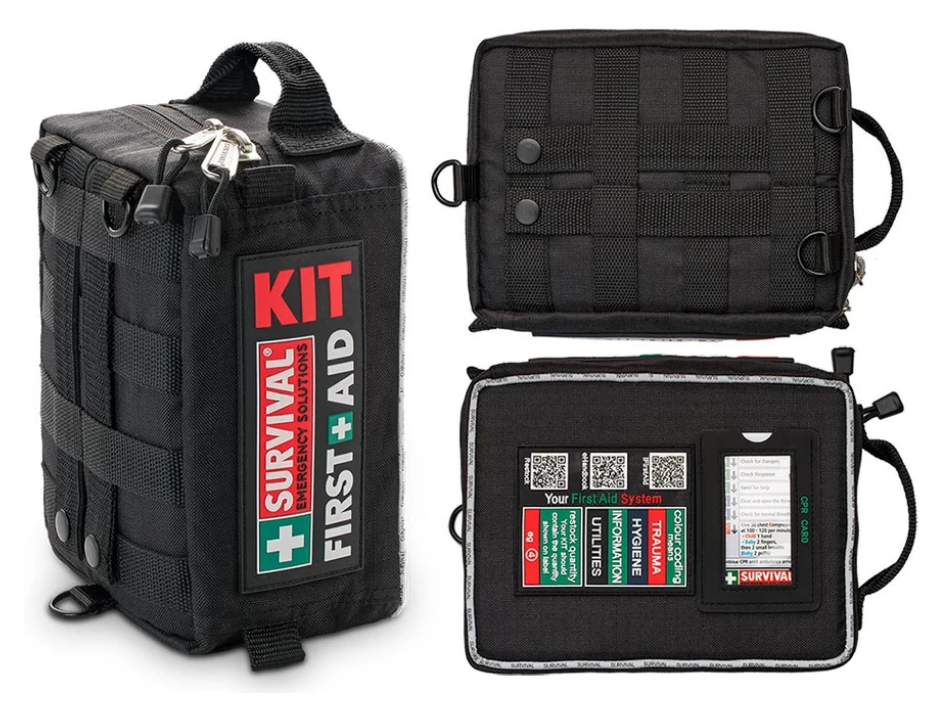
These are top priorities to always carry with you while travelling anywhere remote.
The first aid kit should include infection control items, saline to clean eyes or wounds, bandages, gauze, dressings, burns sheet, sharp scissors and more.
Survival kits should automatically include a small first aid kit. On top of that, they should consist of a swiss army knife, notepad and pencil, hand-powered torch, flint, newspaper, compass, thermal blankets, fishing wire, water purification tablets, whistle and gloves.
Cargo Barriers
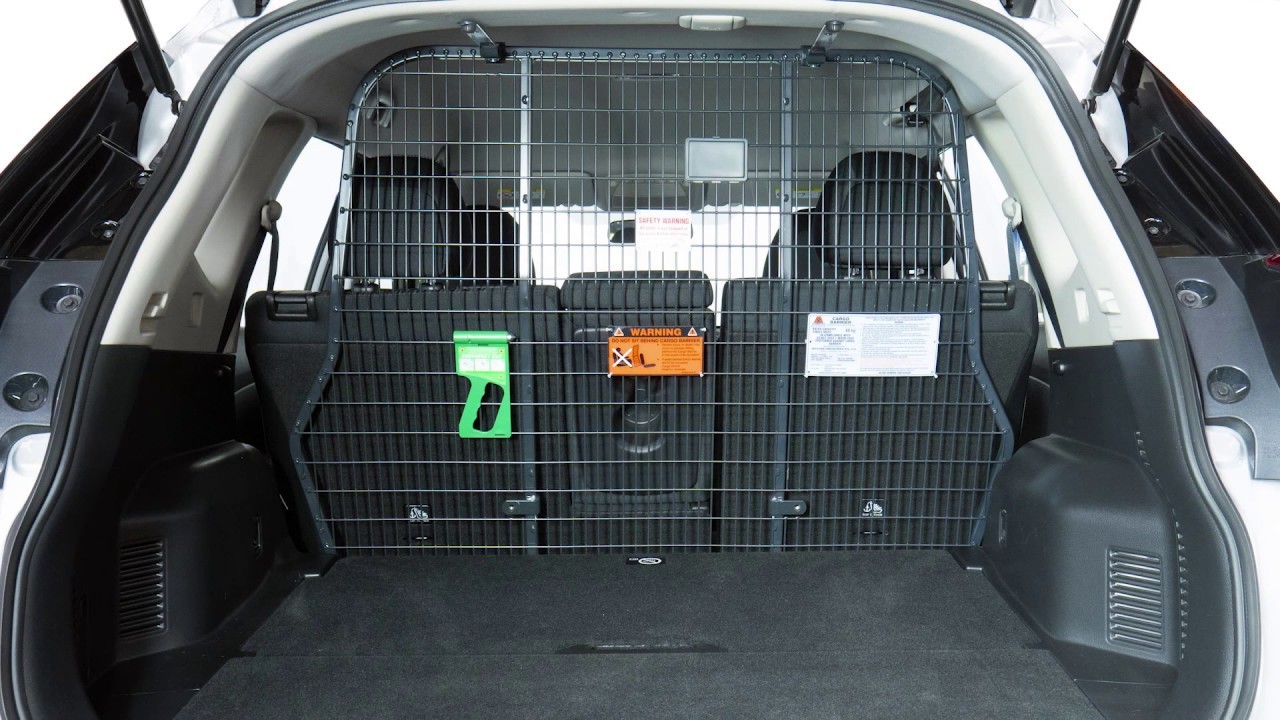
These metal mesh cargo barriers fit between the rear of the vehicle and its occupants. They are handy to stop the contents of the rear flying forwards and injuring someone in case of a crash.
They also make it easier to store items in the rear storage compartment. As a bonus, a cargo barrier can act as a rollover cage preventing deformation of the cabin.
Internal Storage Systems

You can convert the back of your vehicle into a full organized vehicle storage system maximizing the available space right to the top of the back of your car.
A set of shelves, trays and single or double drawers will subdivide the space in the back, giving you easier access to get things in and out without removing lots of gear.
And you can also have your fridge bolted on fridge drop slides allowing easier access.
Tyres

To go offroad, you'll need offroad tyres. It may sound obvious, but it's not.
The standard tyres on a 4wd vehicle are passenger tyres, and they are only designed for road use. They provide insufficient grip and will puncture too easily.
You should consider swapping your tyres to light truck construction tyres with at least an all-terrain tread pattern.
You should be ok if you have a dual cab ute that should have tyres designed for a load, but if you have low profile tyres, you should swap them before going bush.
Suspension
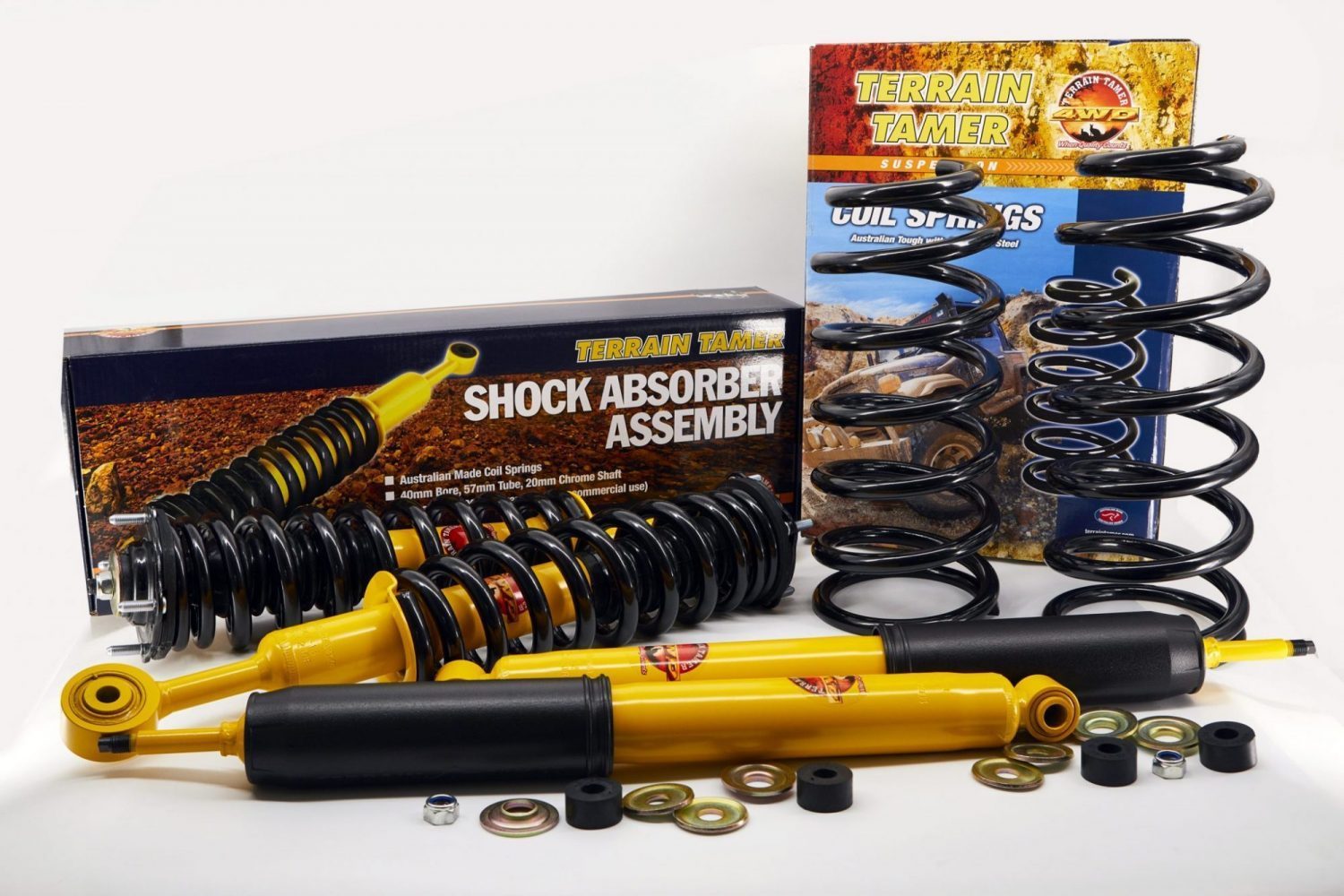
Similarly to tyres, standard 4wd suspension are not designed to have the vehicle be loaded up and driven offroad.
Manufacturers don't spend money providing heavy-duty quality suspension on stock vehicles. If you do light-duty offroading with a small load and don't venture into the outback, then the standard suspension will be adequate.
If you need to load bigger weights and travel to the outback, then a small suspension lift kit would be highly advisable.
A suspension upgrade is very important for safety and transforms a loaded vehicle when offroad or on dirt roads, and particularly when towing.
You can also increase your vehicle GVM (gross vehicle mass) by upgrading your suspensions.
A typical aftermarket kit could be made of four springs and shocks with a lift of approximately two inches.
Tools
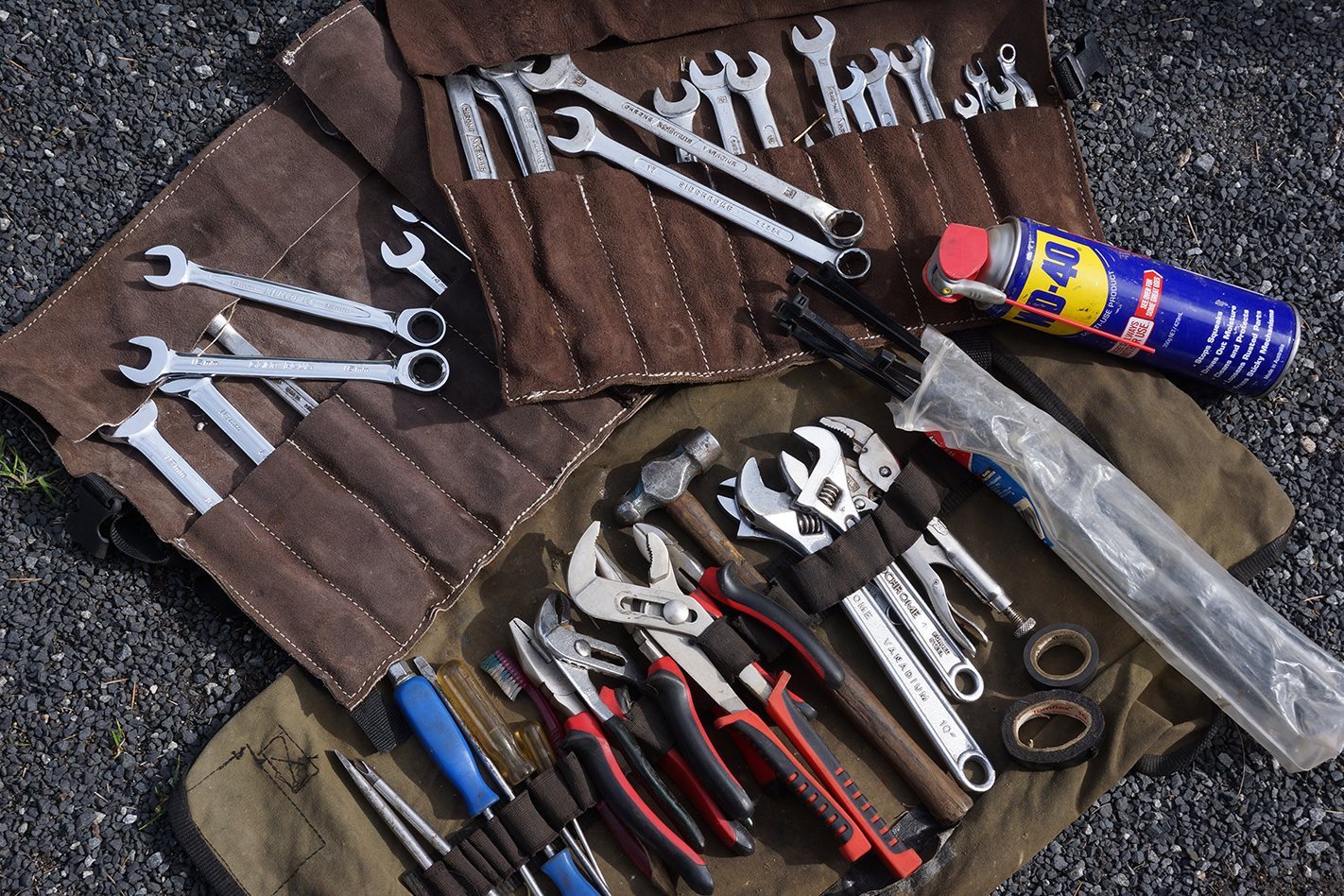
Carrying basic essential tool kits on your trip will be highly recommended in the event you need to fix or modify a broken part.
Tools to take with you include shifting spanners, flat and Philips head screwdrivers, knives, socket set, pliers, hacksaw, hammers, multimeter, mole wrenches, wheel braces.
You can also add workshop manuals, cable ties, fuses, electrical wires, hose clams, thread-locks, wd-40, jump leads, nuts, bolts, screws, emergency windscreen, tyre repair kits, Allen keys.
Spare Parts

The spare parts you decide to take with you will depend on the vehicle and the trip.
Usually, if you are considering a long trip, you could be taking with you some spare: air and fuel filters, extra spare tyres, hoses, belts, electrical wires, fuses, screws, nuts, bolts, rags, light globes, thread lock, cable ties, superglue, wd-40 and a workshop manual.
Air Compressor

An absolute must.
You will need to reinflate your tyres after dropping pressures or to reseat a tyre or rim after it comes off.
Air compressors can be permanently mounted to the vehicle (like under the bonnet) or be portable.
Most compressors are electric at 12V, but there are quicker ones driven by the engine.
UHF Radio
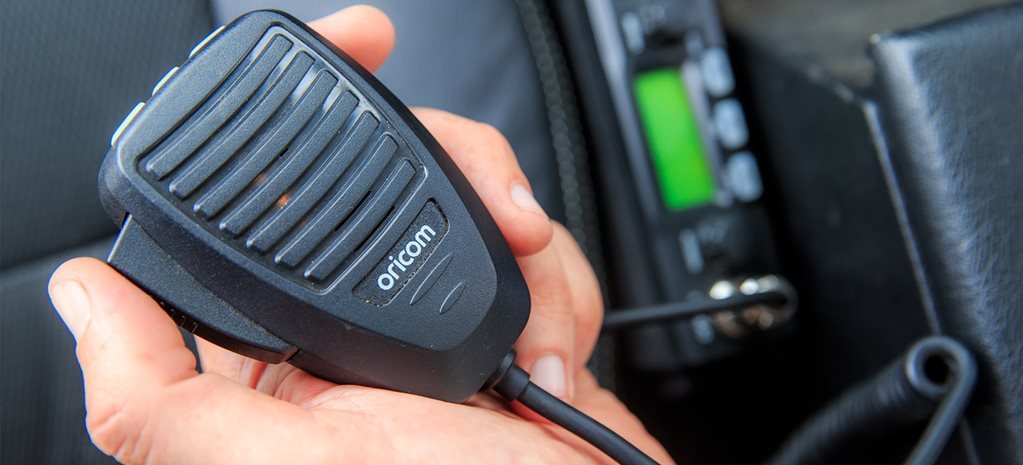
Driving with others is probably much more fun and safer..if you can communicate easily.
But there would be times where you need to communicate with people outside your group.
UHF CB Radios work by having a set of CB frequencies available for public use. No licence or fees, totally free.
Radio units can be vehicle mounted with a range for up to 40Km or handheld usually up to 5km.
A typical mix of types of communication available for touring offroad is UHF Radios to communicate with others in the same group, UHF and HF radio to communicate with other groups, HF Radio and satellite phones to communicate with anyone in the world.
THE WOULD-BE NICE HAVING LIST OF 4WD ACCESSORIES / MODS
Items in this category are debatable wether should be essential or not based on who you ask; however, usually that includes:
Snorkels

Waterproofed relocated air intake that only allows air through the intake.
The main job of 4wd snorkels is to prevent water from going to the engine and by fitting a snorkel to your vehicle means the air intake is very much higher than it was before. So if you decide to cross a deep river, you have more height tolerance not to let water going to the engine.
Other benefits of a snorkel are cleaner air and improved performance, especially in older diesel vehicles.
Breathers
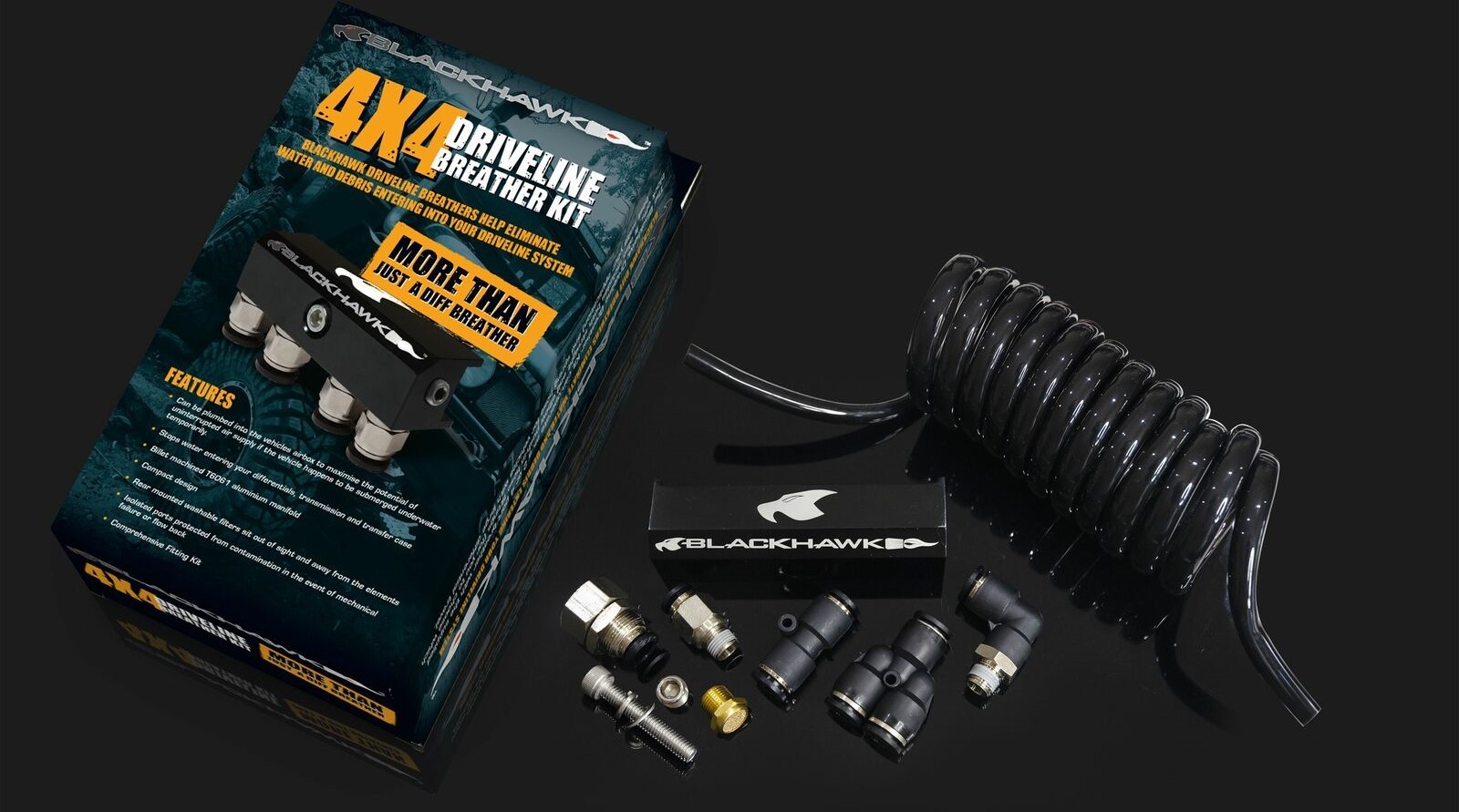
Breathers are a set of pipes which allow air inside the diffs and other components to breath.
The diff can breathe through a long pipe, usually routed to the top of the engine compartment.
A breather kit is an excellent mod to have in situations like water crossing where hot diffs get in contact with cold water, and due to inadequate lubrication, they will eventually get damaged.
Water Storage
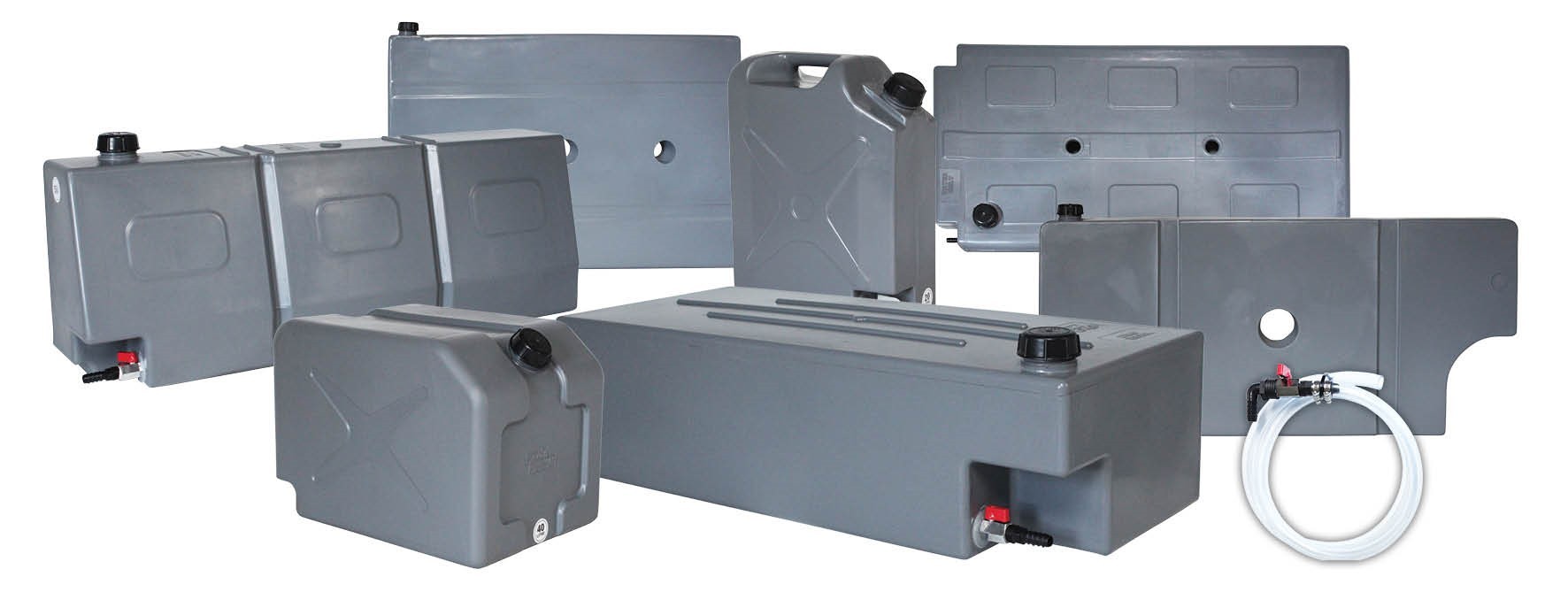
If you make a big trip to the outback, you may need extra water.
So transporting extra water tanks is a smart idea.
They come in all sorts of shapes and sizes and/or you could customize them to live inside or outside your vehicle.
Make sure to use only food-grade hoses for the drinking tank plus a second tank for greywater.
Fridge

A small fridge of approx 20 to 60L capacity is not a real necessity, but kind of is when you are in the outback sun at 45degrees.
You can fit all your trip's cheese, drinks, dairy food fresh and cool, making your life much more comfortable.
Fridges must be adequately secured in the vehicle, and drop fridge slides are the best set up to do so with easier access from the rear of your car.
Fridges need electrical power, and we do not recommend plugging them into the rear 12V socket.
You will probably need a dual battery system for an alternative power supply.
Long Range Fuel Tanks

To drive further with fewer fuel stops.
If you plan a big trip to the outback, you will want to carry extra fuel.
Long-range fuel tanks can be replacements and/or additional fuel tanks.
There are two basics types of long range fuel tanks, replacement and auxiliary.
Replacement tanks will be "replacing" your stock tank with one the has a larger capacity.
Auxiliary tanks are additional separate tanks.
Bash Plates (underbody protection)

These underbody protection metal plates will protect components such as the transfer case, fuel tank and diffs.
Going offroad will always put you at risk of running out of clearance and bash plates will absorb the impact from terrain shielding it from the expensive transmission.
Most stock 4wd vehicles don't come with suitable underbody protection bash plates, so you need to provide a stronger aftermarket alternative.
Bull Bars

Originally the only intent of bull bars was to provide either a replacement or supplementary bumper bar to protect the vehicle in the event of a collision with animals.
Nowadays other than the original purpose, they are also a very useful place to mount winches, lights and antennae.
There are three types of bullbars:
- a nudge bar fits over the existing front bumper and covers part of the bumper.
- an over bumper bar is the same thing but covers the entire bumper
- a bull bar replaces the front bumper completely
The first two categories are usually purely cosmetic with little protection against collision.
The bull bar will give you better protection, and it comes in three types of construction:
- Steel: stronger, cheaper and heavier
- Alloy: lighter, more expensive and better looking (usually)
- Plastic: the lightest of the three but not the toughest.
Rear Bars (Tow Bars)

Rear bars will replace your vehicle rear bumper bar optionally with a wheel carrier or a carrier that mounts onto the chassis and preserves the existing rear bar.
Dual Battery Systems

As mentioned earlier, a dual battery system will come very handy with a fridge as it can provide a second battery in addition to the vehicle starting battery. The second battery can be mounted on specifically designed Single and Dual Battery Trays.
The primary vehicle battery is meant to start the engine and supply the vehicle electrical needs.
But it may not be adequate to run extra accessories such as fridges, electric winches, lights, radio equipment, therefore a second battery would help.
Roof Racks
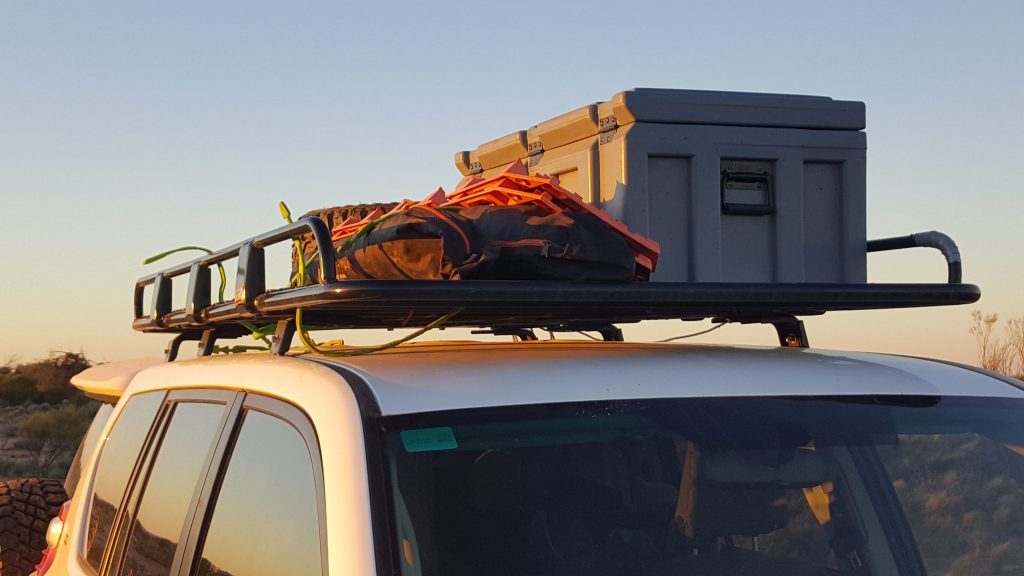
You can never have too much space in a vehicle, and after you fill the interior, the only way to go is to use the roof (unless you tow a trailer).
Roof Racks are handy places to store light and bulky items such as rooftop tents and camping chairs.
Not the best instead for heavy items like fuel or water but if there is no choice, then you will need to be aware of the change on the vehicle handling as well as increased fuel consumption.
Alloy roof racks are as strong as steel and far lighter, so they are highly recommended.
Driving Lights
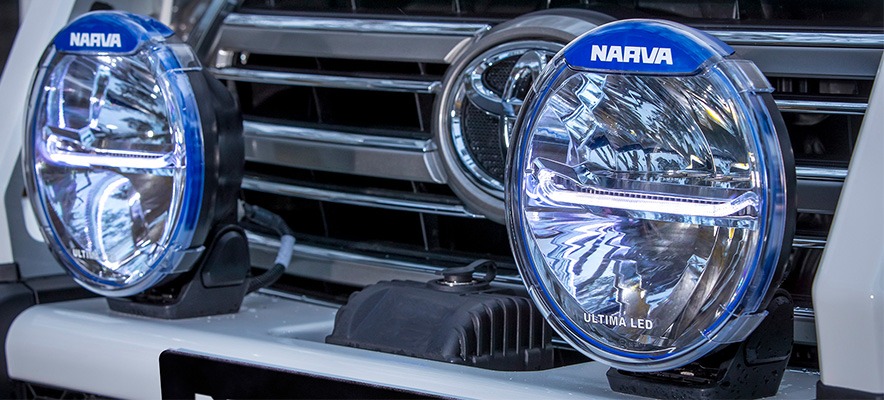
For urban driving, your headlights are more there so others can see you.
For offroad trips, it's all the way around, and you need extra light to light the way.
4wd driving lights usually come in two basic styles:
- Spotlights great for cruising and illuminating a long distance.
- Wide-angle or spread-beam light is better suited for low-speed 4wd work.
And both can be either halogens or HID (High-intensity discharge). The latter is far superior by creating more light using less power. Halogens lights are usually cheaper.
Elockers

Elockers are locking differentials that massively improve the offroad capability for vehicles without modern traction control.
They can really simplify crossing challenging tracks and can be for front or rear.
The rear is usually the better choice since the rear axle is stronger, there are no CV joints to stress, and it's easier to steer with a rear locker than a front.
Rock Sliders

Rock sliders other than helping you get in and out of the vehicle, protect your door sills as you slide over rocks.
The heavy-duty rock sliders are recommended because they can take the weight of the vehicle as it slides over rocks.
They can also work as good support for hi-lift jack in recovery situations.
Winches
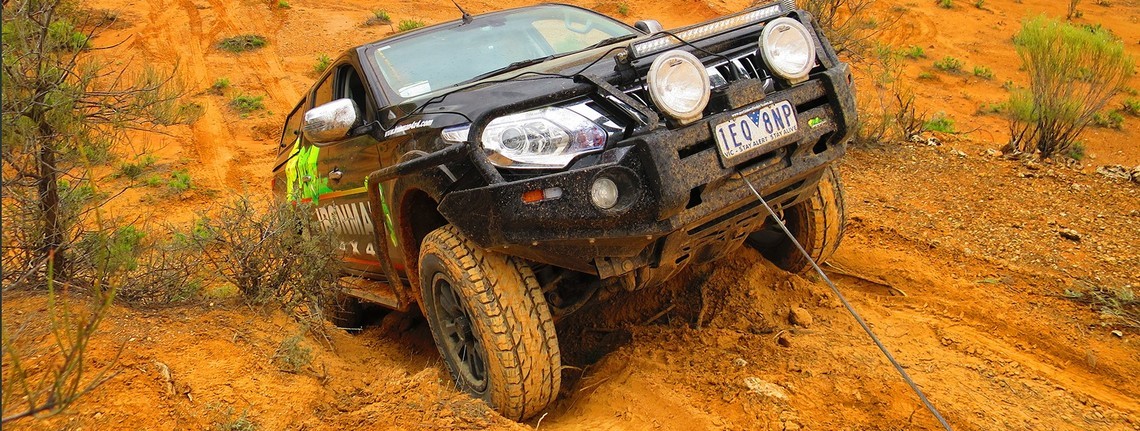
A vehicle recovery with a winch is so much easier!
Usually, the maximum recovery load is around 1.5 times the fully-loaded vehicle weight, and they come in two types, electric winches and hand winches.
An 8000lb to 9500lb winch with a snatch block or two is usually enough for standard offroading.
Other 4wd accessories
The list is still big of all accessories and modifications you can fit in a 4WD if you go out touring.
canopies, heavy-duty clutches, heavy-duty seat covers, awnings and annexes, flares & grilles, cruise control kits, performance exhausts, and many more
Conclusion
It's better to plan which accessories or modifications you are going to need and work through it.
Here at All Four x 4 Spares, we can help you go through all the options and help you choose what's best for your needs.
We have a massive range of 4WD Accessories available in our online store and showroom.
We only stock the best brands such as Brown Davis, Clearview, Darche, Drivetech 4x4, EFS, Ironman 4x4, Msa 4x4, Narva, Piranha Off-Road, Roadsafe 4wd, Terrain Tamer, Tough Dog and many more.
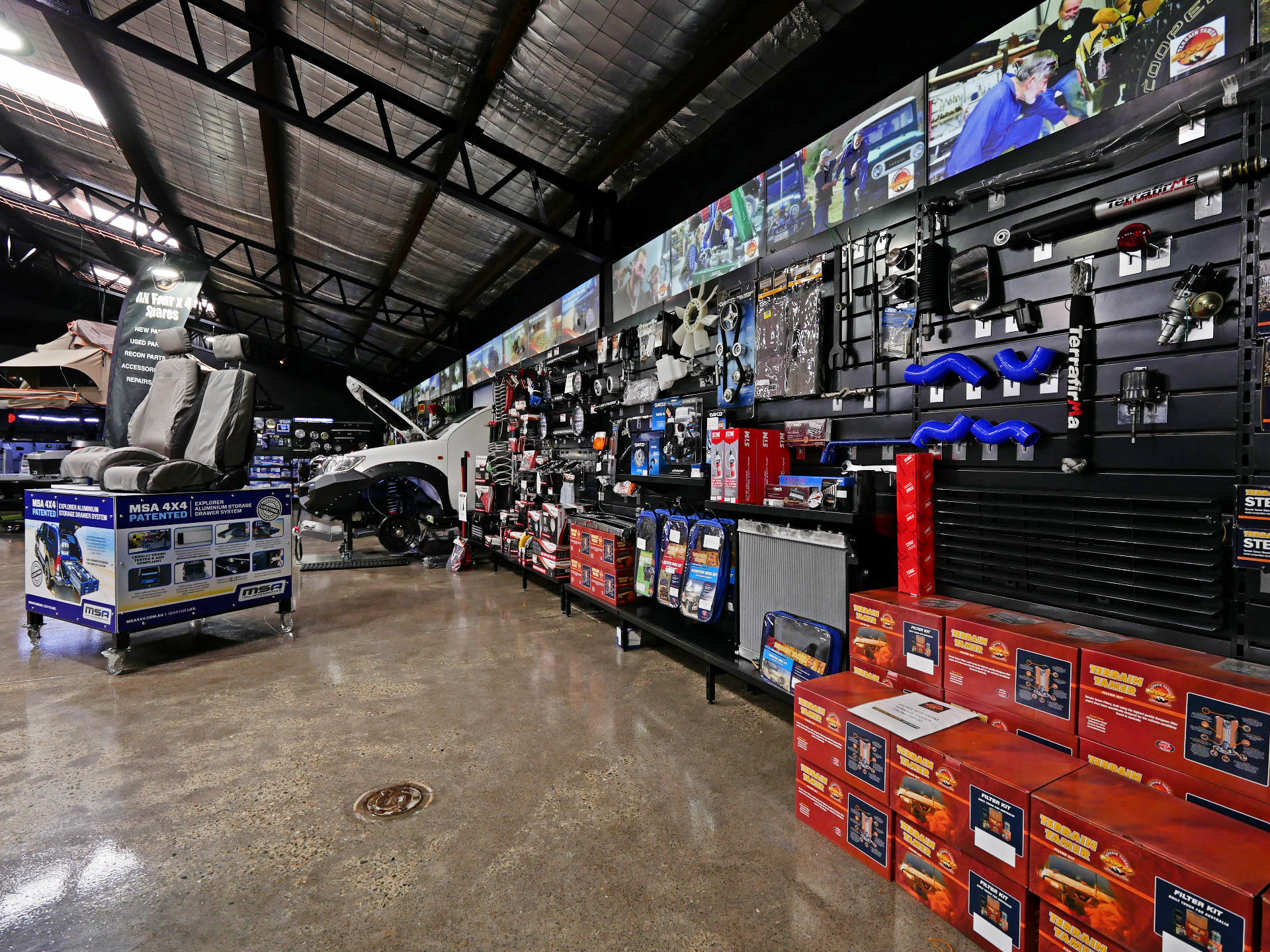
And we can also fit them for you in our workshop service centre.
